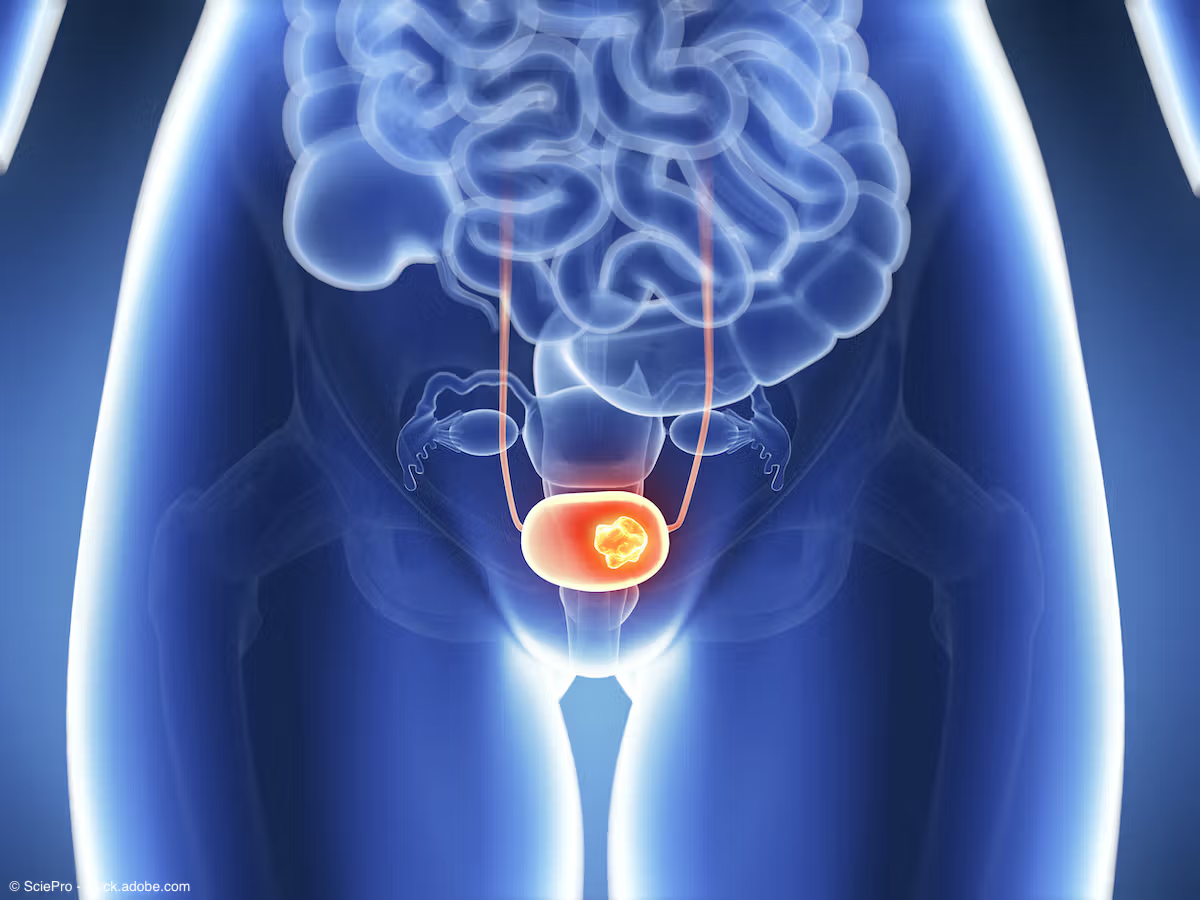News
Article
Plasma ctDNA clearance may be associated with improved outcomes in MIBC
Author(s):
According to the authors, these findings from the VOLGA trial suggest that ctDNA may be a potential biomarker to predict therapeutic benefit in patients with MIBC.
Plasma ctDNA clearance during neadjuvant treatment with durvalumab (Imfinzi) plus tremelimumab (Imjudo) plus enfortumab vedotin-ejfv (Padcev) was associated with improved pathologic response and event-free survival (EFS) in patients with cisplatin-ineligible muscle-invasive bladder cancer (MIBC), according to findings from an exploratory analysis of the phase 3 VOLGA trial (NCT04960709), which were presented at the 2024 European Society for Medical Oncology (ESMO) Congress in Barcelona, Spain.1
Alexandra Drakaki, MD, PhD

According to the authors, these findings suggest that ctDNA may be a potential biomarker to predict therapeutic benefit in these patients.
The VOLGA trial is an ongoing open-label, global study assessing the combination of durvalumab plus tremelimumab plus enfortumab vedotin or durvalumab plus enfortumab vedotin vs standard of care (SOC) in patients with MIBC. Initial data from the safety run-in cohort of the trial were previously reported, showing that 6 of 17 patients in the 3-drug combination arm achieved a pathologic complete response (pCR). Additionally, 9 of 17 patients achieved pathologic non–muscle-invasive response.
Emerging data has also suggested an association between ctDNA and treatment benefit. The current exploratory analysis sought to further assess this potential association between ctDNA and clinical outcomes.
Overall, 62.5% (10/16 patients) of patients were ctDNA-positive and 37.5% (6/16 patients) of patients were ctDNA-negative at baseline. Following neoadjuvant treatment but prior to radical cystectomy, the ctDNA-negative rate increased to 78.6% (11 of 14 patients).
In total, 7 of 10 patients achieved ctDNA clearance, meaning they were ctDNA-positive at baseline and ctDNA-negative prior to radical cystectomy. Among the 7 patients who demonstrated ctDNA clearance, 5 achieved a pCR at the time of surgery, and 2 had no change.
Alexandra Drakaki, MD, PhD, who presented the results on behalf of the VOLGA investigators, also noted during the presentation at ESMO, “What is very important is to point out that those that started ctDNA-positive remained ctDNA-positive, and in fact, at the time of surgery, they were upstaged.”
Similarly, 3 patients were downstaged prior to surgery, 2 of which were ctDNA-negative at both time points (baseline and pre-radical cystectomy) and 1 of which was ctDNA-negative at baseline and did not undergo radical cystectomy.
The investigators also found an association between ctDNA clearance and improved EFS (HR, 0.18; 95% CI, 0.016-2.1). At a median follow-up of 10.8 months (IQR, 8.3-11.0 months), patients who achieved ctDNA clearance and those who were in the ctDNA-negative cohort achieved a longer EFS vs those in the ctDNA-positive cohort.
In total, the safety run-in cohort included 17 patients with MIBC, of whom 14 had baseline plasma samples and underwent radical cystectomy. To be eligible for enrollment, patients needed to be cisplatin-ineligible and have clinical stage T2-4aN0–N1M0 tumors, including T1N1M0.
For the study, patients received 3 cycles of durvalumab, 2 cycles of tremelimumab, and 3 cycles of enfortumab vedotin in the neoadjuvant setting. Patients then underwent radical cystectomy, followed by 9 cycles of durvalumab and 1 cycle of tremelimumab in the adjuvant setting.
Drakaki, an associate professor of hematology/oncology and urology at the University of California, Los Angeles, noted, “What I would like to point out is that tremelimumab was given only for 2 cycles in the neoadjuvant setting and 1 cycle in the adjuvant setting, basically to jumpstart the immune system again. Enfortumab vedotin, which is our targeted chemotherapy, was given only in the neoadjuvant space. This is very important in terms of safety, because people did not really develop long-term toxicity.”
The primary end points for the VOLGA study are safety and tolerability. Secondary end points include pCR and EFS.
Based on these findings, Drakaki concluded in her presentation, “This exploratory analysis supports that ctDNA could be a potential biomarker and may help us predict treatment benefit in those patients. Of course, we need to continue to collect ctDNA as part of the main VOLGA trial.”
Reference
1. Drakaki A, Powles TB, Wang Y, et al. Circulating tumor DNA (ctDNA) clearance with neoadjuvant durvalumab (D) + tremelimumab (T) + enfortumab vedotin (EV) for cisplatin-ineligible muscle-invasive bladder cancer (MIBC) from the safety run-in cohort of the phase 3 VOLGA trial. Presented at: 2024 European Society for Medical Oncology Congress. September 13-17, 2024. Barcelona, Spain. Abstract 1970MO. https://s3.eu-central-1.amazonaws.com/m-anage.com.storage.esmo/static/esmo2024_abstracts/1970MO.html.pdf
Newsletter
Stay current with the latest urology news and practice-changing insights — sign up now for the essential updates every urologist needs.













